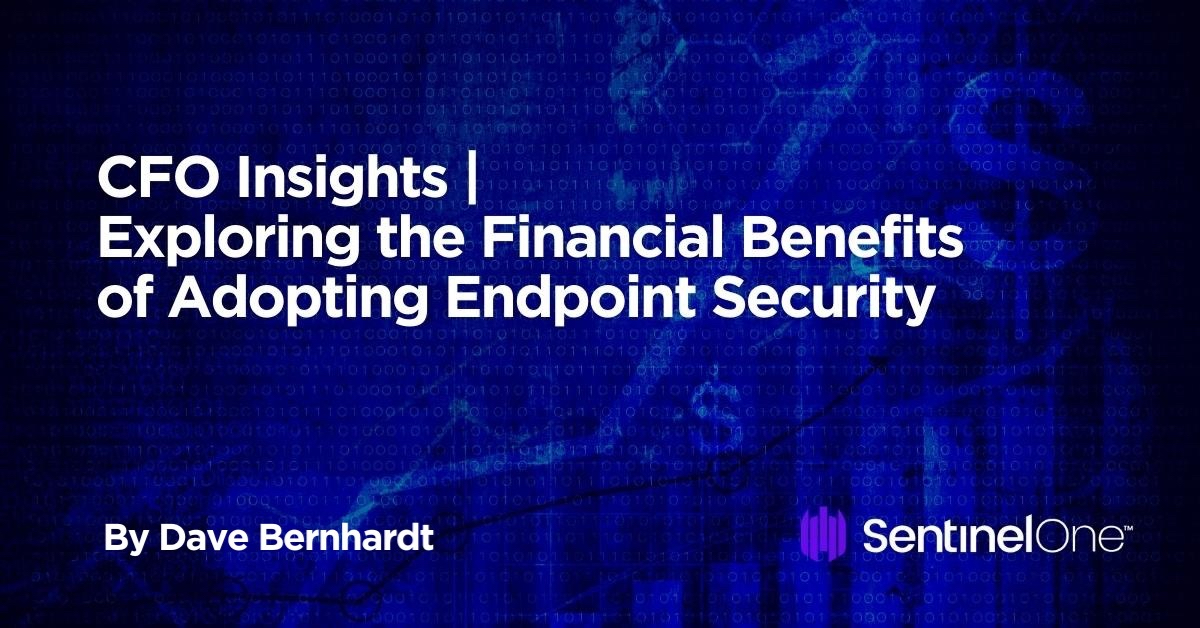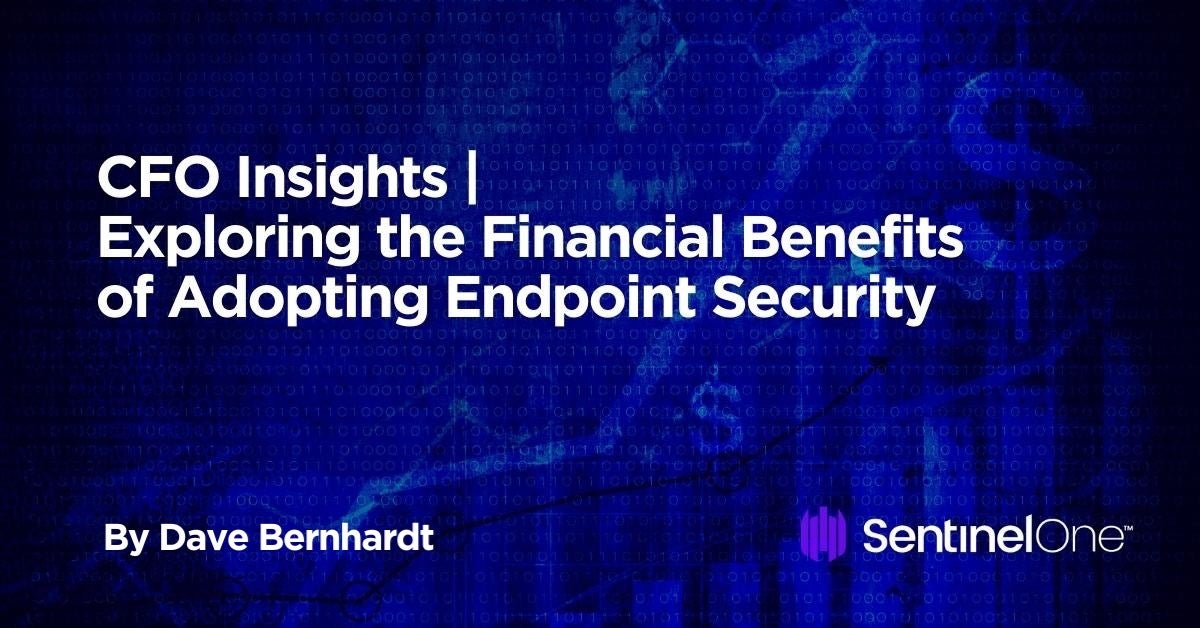
2023-2-6 21:54:31 Author: www.sentinelone.com(查看原文) 阅读量:19 收藏
Over the past two-and-a-half years while I’ve served as Chief Financial Officer at SentinelOne, one thing has become glaringly apparent; the increasing role that Chief Financial Officers (CFOs) now play in staunching the rise in cybersecurity threats.
As technological infrastructures grow, increasing numbers and severity of attacks have put organizations across every industry at severe risk. A CFO’s main responsibility is to maximize their organization’s value, and increased risk threatens that value. Even one successful attack on a business can negatively impact revenues, expenses, and cash flows.
In close partnership with other C-level executives, CFOs can help safeguard their business from a financial point of view by investing in the right processes and technologies. In this post, we’ll explore how a vested interest in understanding and assessing security technology helps CFOs maximize their company’s value while contending with advancing cyber threats.

The True Cost of Endpoint Data Breaches
Hybrid workspaces and soaring numbers of endpoint devices have become prime targets for cybercriminals. Used to gain access to sensitive information and disrupt business operations, risks on the endpoint surface directly affect an organization’s finances. IBM’s Cost of a Data Breach Report 2022 found the following:
- The cost of data breaches stood at an averaged total of $4.35 million.
- The cost of an average ransomware attack, not including the cost of the ransom, came to $4.54 million.
- Companies that had robust incident response (IR) teams and plans saved an average of $2.66 million.
The financial loss stemming from a successful cyberattack goes beyond the immediate costs – ransom payments, extortion fees, damage to IT infrastructure – and extends into long-term ramifications too. Fallout from even one cyber attack can cost an organization months of legal fees, penalties for those in highly regulated fields, operational downtime, and a long-lasting damage of brand and reputation. Organizations that handle personally identifiable information (PII) must face drastically higher costs with affected customers filing lawsuits of their own. While media outlets focus on loss of customer data, the loss of intellectual property (IP) can also devastate a company’s projected growth.
A CFO’s Role in Cybersecurity & Endpoint Understanding
Finance departments oversee all levels of data reporting and CFOs are in tune with where sensitive information is stored, what safeguards are in place, and who has access to it. This makes the CFO a critical player in the effort to strengthen a company’s cybersecurity posture. With endpoints at the heart of every organization, CFOs can help ensure that the right security is in place by implementing endpoint security such as endpoint detection and response (EDR) and extended detection and response (XDR) solutions.
By working closely with an organization’s Chief Information Security Officer (CISO) and technical teams, CFOs can accurately assess the risks associated with their organization’s endpoint devices and determine the appropriate investment level in endpoint security. This may include setting a budget for endpoint security solutions, security staffing, and regularly reviewing the organization’s endpoint security posture to ensure it remains effective in protecting against emerging threats.
Cybersecurity systems not only ensure businesses are protected from fluctuating risks in the threat landscape, but also benefit the organizational growth in the following ways:
- Securing current valuation: Organizations that are unprotected and unprepared will be most vulnerable to the exponential cost of an attack. Robust endpoint security solutions ensure organizations keep their risks low and can obtain cyber insurance at reasonable rates, which requires businesses to show effective security measures.
- Establishing long-term sustainability: Building up a strong cyber resilience means continuing the success and growth of an organization. Protected organizations uphold a positive reputation within their communities and are seen as fiscally responsible, making them the ideal choice for prospective clients and partners.
- Improving overall risk management: C-level executives are focused on business critical items affecting the organization. When cybersecurity receives buy-in from the top of the company, cyber policies and procedures are more likely to be followed and improved for ongoing risk mitigation and management.
Understanding Endpoint Security Attack Vectors
The more a CFO understands the attack vectors associated with endpoints, the better they can allocate resources to reduce risk. CFOs can unite IT staff, operations, security, and legal teams to make sure that their organization’s endpoint devices are properly secured and compliant with relevant regulations.
Securing Endpoint Users
Increasingly, the endpoint has become the forefront of information security and the true perimeter of the enterprise. Users now have more control over their endpoints than ever. Even if they can’t install their own programs, remote work allows users to choose which tools they want added to the cloud and where in the world they connect to work from. This freedom of choice means that a user’s endpoint has transformed into the most exposed target for malicious actors looking to target the enterprise.
As such, protecting endpoints at the user level is crucial to maintaining security across an organization. To protect against human errors, misconfigurations, or malicious insider threats, CFOs can collaborate with the CISO to conduct regular cybersecurity awareness training and instill the notion that endpoint protection is not an obstacle to work processes, but instead, a vital element of it.
Securing IoT Devices
Internet of Things (IoT) devices are a common attack vector in endpoint security, but organizations continue to adopt their use as a means to streamline workflows and communications. Without an endpoint detection solution in place, IoT devices may become blind spots where opportunistic attackers make their entry point. A solution such as EDR or XDR provides continuous monitoring, identifying and mitigating risks introduced by unmonitored IoT devices. By providing visibility into security gaps, having an endpoint security solution saves CFOs from needing to invest in additional scanning services.
A CFO’s Checklist | How to Assess the Cost of Endpoint Security
Cost optimization and scalability fall under the responsibility of any CFO. When assessing the upfront costs of robust endpoint security, here are some best practices CFOs can to consider when selecting the right solution to match the needs of their business:
- Assess the financial impact of endpoint security breaches and determine the appropriate level of investment in endpoint security solutions and staff.
- Allocate budget for endpoint security solutions and technical staff to minimize the risks associated with endpoint security.
- Review the organization’s endpoint security posture regularly to ensure that resources are being used efficiently and effectively.
- Evaluate the costs of implementing and maintaining endpoint security solutions such as EDR or XDR as well as the potential security breach costs.
- Work closely with the technical leads to assess the risks associated with the organization’s endpoint devices and determine the appropriate level of investment in endpoint security.
- Engage the Board of Directors and Audit Committee to ensure that their security expectations are being achieved.
- Review service level agreements (SLAs) if pursuing a solution that provides managed security services and ensure they are adequate for the organization’s needs.
- Ensure compliance with all relevant endpoint security and data protection regulations.
- Consider the financial implications of endpoint security, taking into account the costs and benefits of different security solutions and making informed decisions about implementing endpoint security measures.
SentinelOne’s Endpoint Solution in Action | Case Studies
Hitachi Consulting Protects Their Global Remote Workforce with Endpoint Protection
Hitachi Consulting relies on robust endpoint protection to defend the digital solutions they provide for their 6500 global clients against malicious attacks. Working closely with both clients and partners alike to deliver those solutions, it was imperative for the organization to secure against threats that could impact the entire Hitachi data ecosystem.
Essential success factors for Hitachi were strong protection for the endpoint and autonomous processes. They sought an endpoint security solution that required very little administrative overhead while proving capable of eliminating threats rapidly.
SentinelOne’s single, purpose-built agent was selected to detect, prevent, and respond to advanced cyberthreats and provide the Hitachi team with complete visibility and telemetry for all their individual endpoints. The SentinelOne EPP currently protects more than 6000 endpoints for the organization and saves both time and resources, minimizing the budget once needed for extensive administration and maintenance. Read more here.
Samsung SDS Reinforces Proactive Endpoint Security
To defend against fileless malware and ransomware attacks and strengthen their network boundary security, Samsung SDS recognized the need for IP and URL analysis in response to a changing threat landscape.
After testing various EDRs, the global electronics corporation adopted SentinelOne EPP (endpoint protection platform) for its autonomous, AI-based defenses against zero-day vulnerabilities, malware, ransomware, and new attacks not solvable by next-gen antivirus software.
Post implementation, the single-agent design lessened resource impact and operating costs. By automatically and safely blocking threats without involvement from the user, the EPP minimized the use of endpoint device recourse despite providing many analysis functions. Read more here.
Morgan Sindall Uses AI Protection to Safeguard Complex Value Chain
Construction and infrastructure group, Morgan Sindall, sought to expand their endpoint protection as their work on critical national infrastructure involves sensitive data and intellectual property. The group’s required a security solution that supported their high-volume data flow while simultaneously minimizing the attack surface through effective, automatic remediation.
Fast deployment and minimal interruptions to Morgan Sindall’s 6600 users were key. Their teams worked across multiple operating system platforms and had a mixture of both Windows and Linux machines, so relied on an efficient and effective deployment process to get protection up and running quickly.
SentinelOne’s AI-based protection platform drastically reduced the onboarding time, saving resources that would have been directed to support a longer, drawn-out deployment to all endpoints that other solutions required. Further, SentinelOne’s endpoint security provided a high level of effectiveness that allowed Morgan Sindall maximum flexibility during the COVID-19 pandemic, enabling revenue generating to continue through unprecedented times. Read more here.
Conclusion
CFOs that view cybersecurity as a means of business development and long-term resilience, rather than an additional cost center, can help protect their organization from increasingly complex cyber threats. A key part in establishing a businesses’ security posture relies on CFOs identifying the financial risks associated with data leaks, insider threats, or ransomware attacks. Responsible for the financial security of an organization, CFOs need to communicate the importance of company-wide security investments and underline both the financial benefits as well as the cost of successful attacks.
Organizations across various industries trust SentinelOne to help safeguard their endpoint surface through AI-driven threat hunting and autonomous EDR capabilities. SentinelOne offers in-depth guidance on how to enhance their enterprises’ overall security posture and protect them from incoming threats, no matter how advanced. Learn more by booking a demo or contacting us today.
SentinelOne Singularity XDR
Supercharge. Fortify. Automate. Extend protection with unfettered visibility, proven protection, and unparalleled response.
如有侵权请联系:admin#unsafe.sh